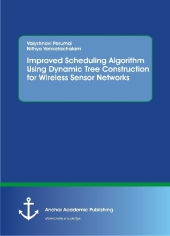 Neuerscheinungen 2016Stand: 2020-02-01 |
Schnellsuche
ISBN/Stichwort/Autor
|
Herderstraße 10
10625 Berlin
Tel.: 030 315 714 16
Fax 030 315 714 14
info@buchspektrum.de |

Vaiyshnavi Perumal, Nithya Venkatachalam
(Beteiligte)
Improved Scheduling Algorithm Using Dynamic Tree Construction for Wireless Sensor Networks
2016. 88 S. 26 Abb. 220 mm
Verlag/Jahr: ANCHOR ACADEMIC PUBLISHING 2016
ISBN: 3-9606703-3-8 (3960670338)
Neue ISBN: 978-3-9606703-3-9 (9783960670339)
Preis und Lieferzeit: Bitte klicken
The Wireless Sensor Network (WSN) composed of several nodes is used for different types of monitoring applications. The objective of deploying WSN is to observe a particular site for monitoring physical parameters like temperature, light, pressure, humidity or the occurrence of a phenomenon. The Sleep/Wake up scheduling for Wireless Sensor Networks has become an essential part of its working.
In this book, the details of Low Energy Adaptive Clustering Hierarchy (LEACH) which introduces the concept of clustering in sensor networks, Energy-Efficient Clustering routing algorithm based on Distance and Residual Energy for Wireless Sensor Networks (DECSA) which describes scheduling based on distance and energy, and the Energy efficient clustering algorithm for data aggregation (EECA) are discussed. The LECSA (Load and Energy Consumption based Scheduling Algorithm) are also discussed.
´Text sample:
Chapter 3.3 DESCRIPTION OF MODULES:
[...].
3.3.1 Cluster formation of WSN:
WSN is to regularly collect information from the sensor node and transmit it to cluster head. The cluster heads are selected by using highest node weighting parameter. Cluster head is organized by the entire sensor node and keeps track of the information of all the sensor nodes. Once the Sensor node is deployed, they will keep operating until there is a discharge.
3.3.2 LEACH (LEACH Low Energy Adaptive Clustering Hierarchy ):
WSN is considered a dynamic clustering method. All the nodes can transmit enough power to reach to the base station and the nodes use power control. The LEACH This network is made up of nodes, which are called as cluster heads. The work of the cluster head is to gather the data from their nearest nodes and transfer it on to the sink node. The LEACH has two phases. They are set-up phase, steady-state phase. In set-up phase cluster heads are chosen. In steady-state the cluster heads are maintained. Every node could transmit data into the corresponding time-slot By single hop communication.
3.3.3 Generalized Self-Organized Tree Based Energy-Balance [GSTEB]:
In each round the sink node assigns a root node and coordinates its sensor nodes. Root node sends the time slot message to all the sensor nodes. These sensor nodes send its message in a round which contains the entire neighbor´s information. If the sensor node doesn´t receive the message means not in the range, so the sensor node moves to sleep state. Therefore a better balanced load is achieved compared with the protocols mentioned.
3.3.4 Initial Phase:
When initial Phase begins token analysis in random allocation. By using Distributed Self-Organization balanced clustering algorithm can divide into three phases. They are cluster head selecting phase, cluster building phase, cycle phase. In the cluster head selecting phase cluster head node broadcasts (Head-Message) through the token analysis. Once all the nodes received this message data packet start traveling form cluster head to cluster members.
In the cluster selecting phase can be divided into two phases. There are set-up phase and steady pace. In the set-up phase cluster are organized by cluster head. Cluster in the K-hop approach forms cluster head. At the beginning time slot the k-hop neighbors to declare itself as cluster head and ask them to join the cluster. The neighbors in k-hop to calculate the respective weight, and then the node with the highest weight will become the cluster head. In the steady phase cluster head transfer the data to the base station.
In the cluster building phase cluster head send the data to the base station if it´s too long to reach the base station, that time cluster building phase generate. By using this phase cluster header to send the data to the nearest active cluster head from their data send to the base station. By this communication cost is reduced. In the last cycle phase is reelecting process.
3.3.5 Tree Construction:
The tree is constructed based on the neighbor´s information. Each node selects its parent node by the sensor node information and its energy. The parent node is computed every node´s neighbor record. If a node has no child node, it defines itself as a leaf node. Parent node directly communicates with the root node and manages the entire child node.
3.3.6 Information Exchanging:
While exchanging information in each round, Parent node has to transmit the data to the root node. If any child node discharges its energy and die. The dying child node should inform to its neighbor node before discharging. Thus, the tree is reconstructed within short time to save the energy by using this tree based routing load and energy consumption of network. GSTEB is based on the connectivity density and the distance from the base station.
GSTEB sets the threshold size for all the c


